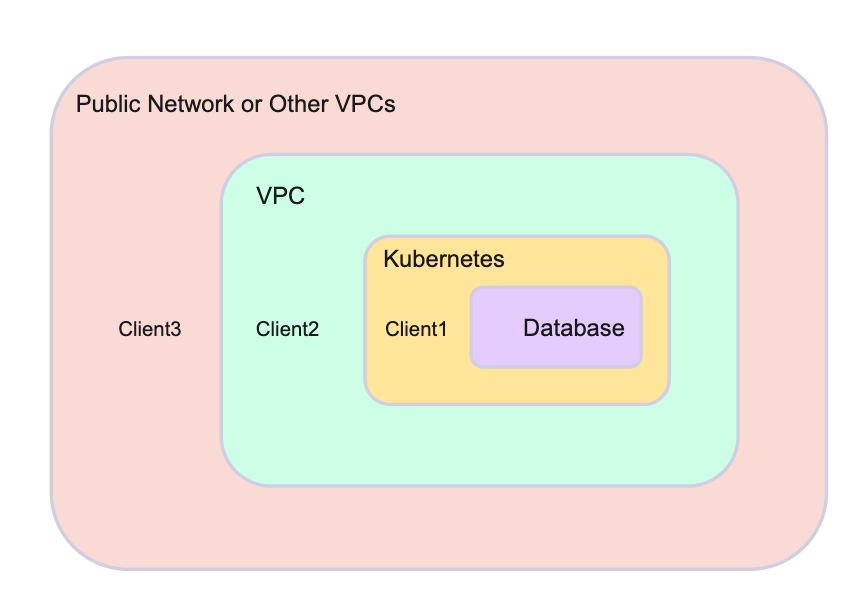Connect database in production environment
In the production environment, it is normal to connect a database with CLI and SDK clients. There are three scenarios.
- Scenario 1: Client1 and the database are in the same Kubernetes cluster. To connect client1 and the database, see Procedure 3.
- Scenario 2: Client2 is outside the Kubernetes cluster, but it is in the same VPC as the database. To connect client2 and the database, see Procedure 5.
- Scenario 3: Client3 and the database are in different VPCs, such as other VPCs or the public network. To connect client3 and the database, see Procedure 4.
See the figure below to get a clear image of the network location.

Procedure 3. Connect database in the same Kubernetes cluster
You can connect with the database ClusterIP or domain name. To check the database endpoint, use kbcli cluster describe ${cluster-name}.
kbcli cluster describe x
>
Name: x Created Time: Mar 01,2023 11:45 UTC+0800
NAMESPACE CLUSTER-DEFINITION VERSION STATUS TERMINATION-POLICY
default apecloud-mysql ac-mysql-8.0.30 Running Delete
Endpoints:
COMPONENT MODE INTERNAL EXTERNAL
x ReadWrite x-mysql.default.svc.cluster.local:3306 <none>
Topology:
COMPONENT INSTANCE ROLE STATUS AZ NODE CREATED-TIME
mysql x-mysql-0 leader Running cn-northwest-1b ip-10-0-2-184.cn-northwest-1.compute.internal/10.0.2.184 Mar 01,2023 11:45 UTC+0800
Resources Allocation:
COMPONENT DEDICATED CPU(REQUEST/LIMIT) MEMORY(REQUEST/LIMIT) STORAGE-SIZE STORAGE-CLASS
mysql false 1 / 1 1Gi / 1Gi data:10Gi <none>
Images:
COMPONENT TYPE IMAGE
mysql mysql registry.cn-hangzhou.aliyuncs.com/apecloud/apecloud-mysql-server:8.0.30-5.alpha2.20230105.gd6b8719.2
Events(last 5 warnings, see more:kbcli cluster list-events -n default x):
TIME TYPE REASON OBJECT MESSAGE
Procedure 4. Connect database with clients in other VPCs or public networks
You can enable the External LoadBalancer of the cloud vendor.
The following command creates a LoadBalancer instance for the database instance, which may incur expenses from your cloud vendor.
kbcli cluster expose ${cluster-name} --type internet --enable=true
To disable the LoadBalancer instance, execute the following command.
kbcli cluster expose ${cluster-name} --type internet --enable=false
The instance is inaccessible after you disable the LoadBalancer instance.
Procedure 5. Client outside the Kubernetes cluster but in the same VPC as the Kubernetes cluster
A stable domain name for long-term connections is required. An Internal LoadBalancer provided by the cloud vendor can be used for this purpose.
The following command creates a LoadBalancer instance for the database instance, which may incur expenses from your cloud vendor.
kbcli cluster expose ${cluster-name} --type vpc --enable=true
To disable the LoadBalancer instance, execute the following command.
Once disabled, the instance is not accessible.
kbcli cluster expose ${cluster-name} --type vpc --enable=false